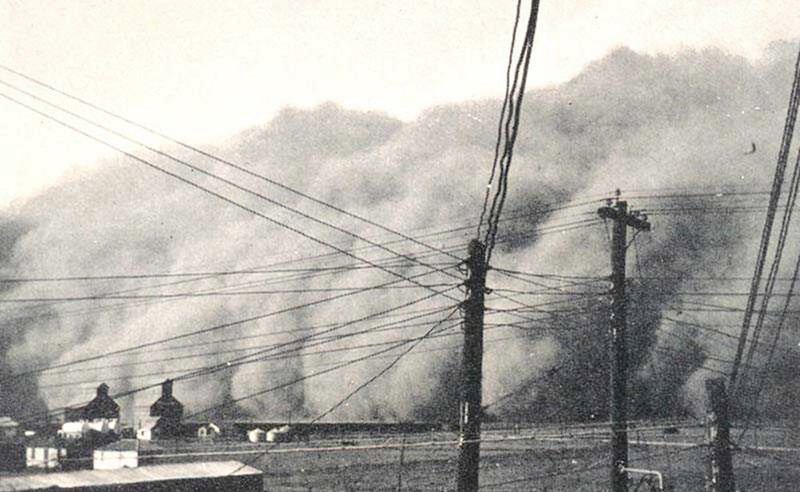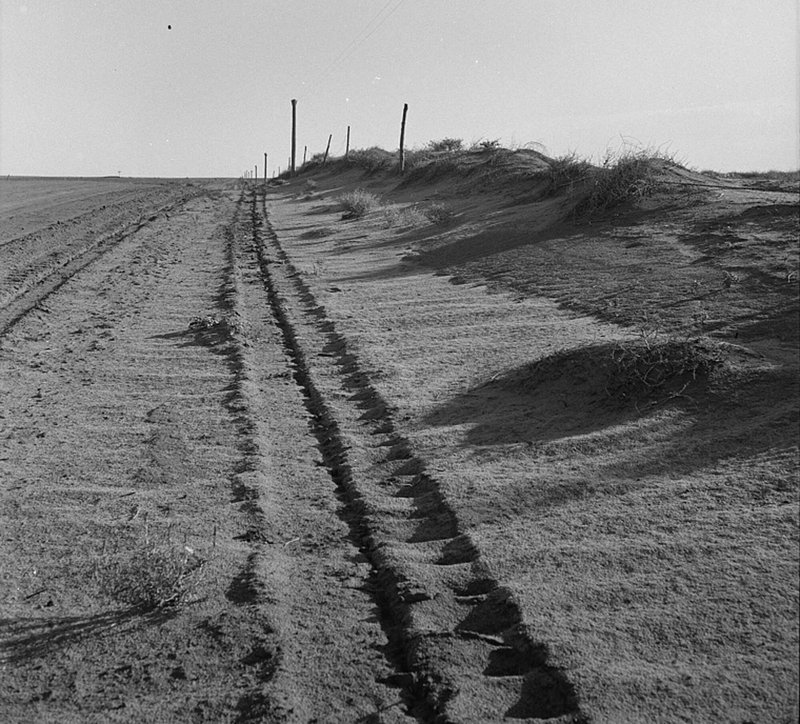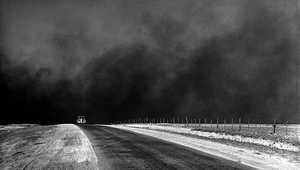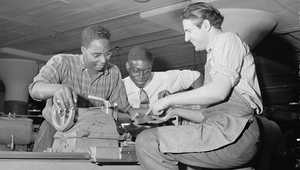The Drought
The Dust Bowl got its name on April 15, 1935, the day after Black Sunday.

April 14, 1935, dawned clear across the plains. After weeks of dust storms, one near the end of March destroying five million acres of wheat, people grateful to see the sun went outside to do chores, go to church, or to picnic and sun themselves under the blue skies. In mid-afternoon, the temperature dropped and birds began chattering nervously. Suddenly, a huge black cloud appeared on the horizon, approaching fast.
Those on the road had to try to beat the storm home. Some, like Ed and Ada Phillips of Boise City, and their six-year-old daughter, had to stop on their way to seek shelter in an abandoned adobe hut. There they joined ten other people already huddled in the two-room ruin, sitting for four hours in the dark, fearing that they would be smothered. Cattle dealer Raymond Ellsaesser tells how he almost lost his wife when her car was shorted out by electricity and she decided to walk the three-quarters of a mile home. As her daughter ran ahead to get help, Ellsaesser’s wife wandered off the road in the blinding dust. The moving headlights of her husband’s truck, visible as he frantically drove back and forth along the road, eventually led her back
The storm on Black Sunday was the last major dust storm of the year, and the damage it caused was not calculated for months. Coming on the heels of a stormy season, the April 14 storm hit as many others had, only harder. “The impact is like a shovelful of fine sand flung against the face,” Avis D. Carlson wrote in a New Republic article. “People caught in their own yards grope for the doorstep. Cars come to a standstill, for no light in the world can penetrate that swirling murk…. The nightmare is deepest during the storms. But on the occasional bright day and the usual gray day we cannot shake from it. We live with the dust, eat it, sleep with it, watch it strip us of possessions and the hope of possessions. It is becoming Real. The poetic uplift of spring fades into a phantom of the storied past. The nightmare is becoming life."

The next day, on April 15, 1935, Robert Geiger, a reporter for the Associated Press, traveled through the region and wrote, "Three little words achingly familiar on a Western farmer's tongue, rule life in the dust bowl of the continent - if it rains." The term ‘dust bowl’ stuck, and began appearing in radio broadcasts and news publications, in private letters and public speeches. Residents hated the label, which was thought to play a part in diminishing property values and business prospects in the region.
The drought alone did not cause the black blizzards. Although dry spells are unavoidable in the region, occurring roughly every 25 years, it was the combination of drought and misuse of the land that led to the incredible devastation of the Dust Bowl years. Originally covered with grasses that held the fine soil in place, the land of the southern plains was plowed by settlers who brought their farming techniques with them when they homesteaded the area. Wheat crops, in high demand during World War I, exhausted the topsoil. Overgrazing by cattle and sheep herds stripped the western plains of their cover. When the drought hit, the land just blew away in the wind.
A letter from an Oklahoma woman, later published in Reader's Digest magazine, recalls June of 1935. "In the dust-covered desolation of our No Man's Land here, wearing our shade hats, with handkerchiefs tied over our faces and vaseline in our nostrils, we have been trying to rescue our home from the wind-blown dust which penetrates wherever air can go. It is almost a hopeless task, for there is rarely a day when at some time the dust clouds do not roll over. 'Visibility' approaches zero and everything is covered again with a silt-like deposit which may vary in depth from a film to actual ripples on the kitchen floor."
Beginning in 1935, federal conservation programs were created to rehabilitate the Dust Bowl, changing the basic farming methods of the region by seeding areas with grass, rotating crops, and using contour plowing, strip plowing, and planting "shelter belts" of trees to break the wind. Farmers were defensive when outsiders criticized their farming methods. Only when they were paid did they begin to put the new farming techniques into practice. The dollar per acre they earned often meant the difference between being able to stay a bit longer or having to abandon their land. As historian Robert Worster wrote, "The ultimate meaning of the dust storms of the 1930s was that America as a whole, not just the plains, was badly out of balance with its natural environment. Unbounded optimism about the future, careless disregard of nature's limits and uncertainties, uncritical faith in Providence, devotion to self-aggrandizement - all these were national as well as regional characteristics."







